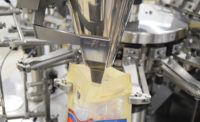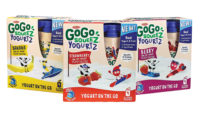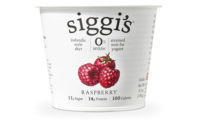In a first for sour cream, Daisy Brand, Dallas, now sells a squeezable, tube-shaped pouch package with a threaded flip-top dispensing closure alongside its traditional tub packaging at major retailers throughout the United States. The 14-ounce, squeezable pouch enables one-handed, spoon-free dispensing.
Developed with convenience and freshness in mind, the Daisy Squeeze Sour Cream pouch stands cap-down, fits in a refrigerator door and is easy to use for small or elderly hands. When squeezed, the pouch dispenses sour cream evenly and exactly through a one-way valve in the flip-top closure. The patented design features a ring-pull tab in the threaded neck similar to the structure used on some gabletop cartons of cream.
When opened the first time, the cap is twisted off, the pull tab is removed, and the cap is replaced. During and after dispensing, the valve prevents air ingress and helps protect product freshness.
“Consumers were asking for a better way to use sour cream as a topping with greater precision than a spoon allows,” said Craig Ziemkiewicz, director of marketing at Daisy Sour Cream. “Our flexible package is both fun and easy to use, allowing consumers to squeeze a dollop of Daisy exactly where they want it,” he added.
Packaging bulk dairy products
Pouches are popular for bulk dairy products, particularly fluid milk dispensed in foodservice settings. They also are a common retail package for milk in Canada. The Wisconsin-based convenience store chain (and dairy processor) Kwik Trip Inc. uses pouches, too.
Advances in aseptic packaging could open new opportunities for extended-shelf-life and shelf-stable pouched dairy products and conversions from rigid containers. Cold aseptic filling consumes less water and energy than hot-fill or retort processes, enhancing sustainability profiles and reducing costs.
Liqui-Box, Richmond, Va., which has supplied equipment and bag-in-box packaging and pouches for bulk milk products for many years, has introduced an entry-level aseptic filling machine. Designed to handle low- or high-acid liquids, the Aseptipack machine is capable of fills ranging from 2 to 20 liters (about one-half to 5.25 gallons).
Aseptic cold-fill products can be produced via a patented liquid-to-gas sterilization process developed by Performance Packaging of Nevada, Las Vegas, and code-named “Pixie Dust.” Compatible with any sealed package, including stand-up pouches and bag-in-box designs, the process eliminates the need for irradiation, hot-filling or post-pasteurization.
“Pixie Dust treatment provides an already-sterilized package and when combined with the appropriately pasteurized product, makes hot-filling unnecessary and allows antiseptic cold-filling,” explained Joseph Dunn, vice president of Research and Development and Regulatory Affairs at Performance Packaging.
“We are currently seeking worldwide partners in the pharmaceutical and food industries to implement this technology,” said Performance Packaging President Rob Reinders.
The Pixie Dust package treatment process occurs prior to filling and has the potential for being integrated with any aseptic liquid filler.
“We anticipate playing a key role in the integration process,” said Dunn, noting his company could pursue equipment development in-house or in partnership with a machinery builder.
In tests by Performance Packaging where Bacillus atrophaeus ATCC 9372 spores (which are highly resistant to heat and chemicals such as hydrogen peroxide) and the Pixie Dust agent were added to package contents, no viable spores were recovered after about two days at room temperature. Treated samples included 4-liter hot-fill bag-in-boxes, 55-gallon drum bags and 2.5-gallon polyolefin milk bags.
In addition, the smell- and taste-neutral GRAS (generally recognized as safe) Pixie Dust agent generates process residuals below the U.S. Food and Drug Administration “Threshold of Regulation.” It also costs less than other options.
“We have dramatically reduced the cost of the sterilization process to an amount of, for example, about $0.01 of agent [to] treat approximately 750,000 pouches,” Dunn said. “In contrast, large volumes of peroxide (such as 250 gallons of very expensive, high-concentration hydrogen peroxide and hot, sterile air) are required to sterilize a similar number of form-fill-seal packages. Pixie Dust is a cost-saving alternative to traditional shelf-stable methods such as hot-filling, retort processing, peroxide or peracetic baths or sprays, irradiation, pulsed light or electron-beam irradiation.”
Dunn said that Pixie Dust enables “new paradigms” in the bag-in-box and filling machinery environments, adding that many industries, including dairy, will benefit from this innovative and relatively inexpensive technology.
Another option for cold aseptic filling, the premade, standup AseptiPouch from Ampac, Kirchberg, Switzerland, is gamma-irradiated and shipped for filling on Astepo aseptic filling machines. To preserve sterility, a flip-top cap on the fitment spout is removed prior to filling and immediately replaced afterward while the pouch is still in the controlled atmosphere of the filling environment. Compatible with filling low-acid dairy products, the pouches are available in three sizes: 200, 500 and 1000 grams (about 7 ounces to 35.25 ounces).



